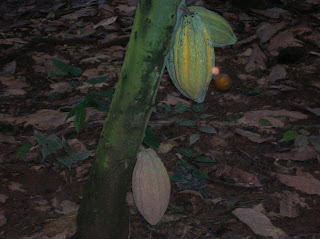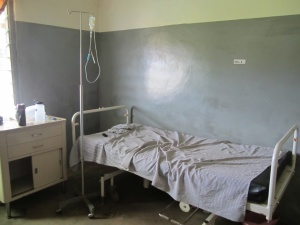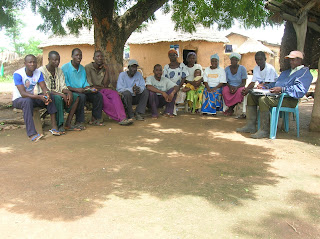Recently I headed to Kumasi for my mid-placement retreat with the other volunteers. For this we headed to Kumasi and visited the Kuapa Kokoo Cocoa company. Kuapa Kokoo is a Fair Trade certified cocoa famers’ cooperative organization in Ghana. It is the only cocoa company to have Fair Trade
certification in Ghana. Pictures are below the lengthy bit of text!
Ghana has 60% of its population working in agriculture, of which cocoa is the largest export, as Ghana is the second biggest supplier of cocoa in the world. Most of the world’s Fair Trade chocolate comes from Kuapa Kokoo, the largest cocoa company in Ghana, with over 1500 farmer groups and 65,000 farmers. From Ghana the beans go to the Netherlands where they are processed into bulk chocolate. These chocolate blocks are then sent to Belgium, Switzerland, England, the United States of America, Canada, and other wealthy nations where companies add their own special ingredients to make finished chocolate
for consumers to enjoy. Kuapa Kokoo is unique in that it owns large shares in the Divine Chocolate company U.K. and U.S.A. Divine Chocolate is Fair Trade certified, is sold at places like the Body Shop and Ten Thousand Villages in Canada, and thus adds associated prestige and benefit for the company in
Ghana. Kuapa Kokoo gets to reap a share of the profits from the sale of Divine Chocolate, thus allowing them to give cash payments to cocoa farmers in Ghana.
Fair Trade certification allows a guaranteed minimum price per metric tonne for cocoa to be paid to farmers, regardless of fluctuation in the trading price on the world market. In addition, farmers are given a price premium on top of that guaranteed minimum price, ensuring that they are able to earn a living
wage and earn more than non-certified cocoa farmers. For example, the price of cocoa, which is fixed by the Ghana government's Cocoa Board, may pay $2,000.00 per metric tonne of cocoa produced to producers. Fair Trade certification would give each farmer an additional $150.00 per metric tonne as
a premium directly to the farmer or farmer group. In addition, because Kuapa Kokoo owns shares of Divine Chocolate, the share of profits they own can be distributed to farmers in the form of cash payments. Also, being fair trade certified, farmer groups and communities get to propose community projects to enhance the
living conditions and quality of life they enjoy. If a project gets approved, communities get to enjoy a project that all of its members have agreed upon. Examples of past projects include the construction of school buildings, purchasing of corn mill/oil extractors, boreholes/hand dug wells, mobile medical clinics,
machetes for all members, and training and educational workshops to enhance their skills and practices.
Pros versus Cons:
Pros:
Based on a tour to a cocoa community which was Fair Trade certified, I would argue that for cocoa farmers in Ghana, being Fair Trade certified outweighs the costs.
Pros include the following:
-A guaranteed price for farmers
-A $150.00 premium for each tonne produced
- The Co-op owns 40% of shares in Divine Chocolate U.K., thus setting them apart, as they get dividend payments from profits in U.K. for the sales of Divine Chocolate
-The company structure is is bottom up
-The executive committees are democratically elected
-The first female president of the co-op was elected in August
-Organization is very gender balanced and empowering
-Micro-finance schemes for woman have been created
-All members are farmers
-Gives benefits that farmers actually need back in their home communities
-Kuapa Kokoo has created a credit union, a farmers trust, a union, Divine Chocolate, and Kuapa Kokoo limited (office for business affairs), and a commercial wing
-Office staffed by farmers who have ability to elect and fire staff if they wish
-Farmers are ones who own Divine Chocolate
-Pride/prestige exists amongst farmers as they are ones who own U.K. chocolate company
-The more they sell to fair trade, the more increase in social premium = direct cash bonuses to farmers (direct incentives)
-Social projects: schools, water wells/bore holes, woman’s group’s, small micro-credit programs have all been created
-Skills training workshops are provided to benefit the whole community i.e. soap, palm oil production training, implements for these are provided
-Multi-National Corporation Cadbury has signed a deal with Kuapa Kokoo, ensuring a large increase in sales and premiums for farmers. This is as Cadbury senses a need to get on board with fair trade due to consumer pressure.
-Raise cocoa farmers to a dignified position where they are proud of their livelihood and that they can provide for their families
-Environmental standards: Educate farmers and monitor the work they do. Train them via farmer field schools to get them to change poor practices. i.e. too much shade = disease.
Cons:
-Non-members do not see cash benefits, however members and non-members still get benefit in community via community projects i.e. water bore holes
-over-supply farmers grow has to be sold for the market price with no social premium
-cost of certification is high, however this has been overcome as the Kuapa Kokoo pays for it, and farmers only need to pay a minimal fee i.e. $1.00GHc, which does not come close to benefits afforded by being fair trade certified
-Requiring Multi National Corporations to buy in to Fair Trade market, which creates future contract security concerns
-Divine: must deal with middle-man grinder in Holland for chocolate making
-Cost = biggest hindrance to Ghanaian's as the majority can not afford to buy it as to them it is a luxury food. It they could bring the cost down people could buy it.
-No future plans to investigate selling chocolate in Ghana, only make for divine overseas as concern over making it in Ghana, as chocolate would have to be harder and of lower quality to hold up in Ghana's climate.
-Cadbury is developing 100+ communities of their own in Ghana, which once
they get Fair Trade certified means Kuapa will need to fill a big contract gap
Kaupa Kokoo office in Kumasi
Me and the EWB team at a farmer community tour
Cocoa Trees
Cocoa Pods/fruit
Cocoa nuts inside
Fermenting of Cocoa nuts (7 Days)
(Drying of Cocoa Nuts - 7 Days)
Dried cocoa nuts ready for bagging and transport





























